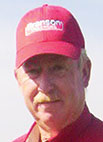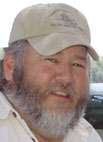
Stevie Haller is passionate and knowledgeable about livestock farming. The owner of 350 head of purebred Gelbvieh and another 100 crosses, 48 of them the promising Gelbvieh/Angus Balancer cross, Stevie, his wife Brenda, a registered nurse, and their two sons’ families operate Haller Farms. They also recently opened Haller Motorworx, a Branson Tractor farm equipment business. Stevie modestly claims that the secret to his many successes is “to always try to listen to people who know more than I do.” At this point in his career, though, most people are keen on listening to what Stevie has to say.
Raised on a cattle farm, Stevie had his own herd by the age of 17. He married his wife of 40 years when he was only 18 and immediately went to work supporting his family. He eventually completed an Agriculture Education degree at the University of Arkansas, and for the next 25 years, Stevie carefully divided his time between farming and teaching.
Although he has long raised cattle, Stevie only bought his first Gelbvieh nine years ago. A German breed introduced to the United States in the 1970s, these cattle were not well known in most livestock circles, though Stevie had long mentioned the breed to his students. After purchasing his first bull in 1999, and then buying out a small herd from the same source later in the year, Stevie was a believer.
Gelbvieh are easy to work and are known for their docility. They are also heavy milk producers, muscle rapidly, and have proven calving ease, though Stevie says that—like any other breed—their calving ease is contingent upon many things. Still, he agrees that the Gelbvieh are superior in this respect.
Docility and calving ease are two of the qualities recommending the breed strongly, particularly to someone as market savvy and easy-going as Stevie Haller. He quips about the relative ease in working the Gelbvieh, “they’re an old man’s cattle.” They are also highly desirable cattle right now, and Stevie has an edge since he owns both red and black purebreds. He points out that the market often inspires farmers to purchase the black Gelbvieh, but he also says, “Those who want a red, want a red.” Stevie keeps meticulous records to document the purebred quality of both his red and black Gelbvieh, accommodating the many needs of buyers.
Stevie tries to keep his purebred herds small, stating that he sees 50 cows to one bull as the extreme outer limit for herd size. Fences provide perhaps the biggest worry to the purebred farmer, he notes, for he has to be constantly diligent in order to ensure his herd’s purity.
Despite the difficulties of raising any purebred cattle, Stevie and Brenda strongly endorse the Gelbvieh. The only real drawbacks they have noticed occur because good qualities can become extreme. Stevie explains that these heavy milk producers can sometimes suffer engorged and even ruptured udders. Similarly, Stevie struggles to keep weights down, since Gelbvieh gain with exceptional ease. He feeds grass fertilized almost exclusively with chicken litter, and he feeds hay; he also adds range meal supplements while cows are lactating.
The Haller name is well respected in Arkansas, as the Hallers rank among the most decorated of farming families in the state. In addition to Stevie’s success as a livestock farmer and legacy as the Booneville High School agriculture teacher, one of his sons, Steven Haller, who has a broiler farm and works at the USDA, invented an important implement for drilling chicken litter into the ground. Stevie’s other son, Joe, along with his wife and three children, is currently contending for Arkansas Farm Bureau’s Young Farmers and Ranchers Achievement Award for the third consecutive year. Although hard work and intelligence have gone far to earn the Haller family such accolades and successes, Brenda demonstrates trademark Haller modesty, concluding, “God’s been good to us.”







